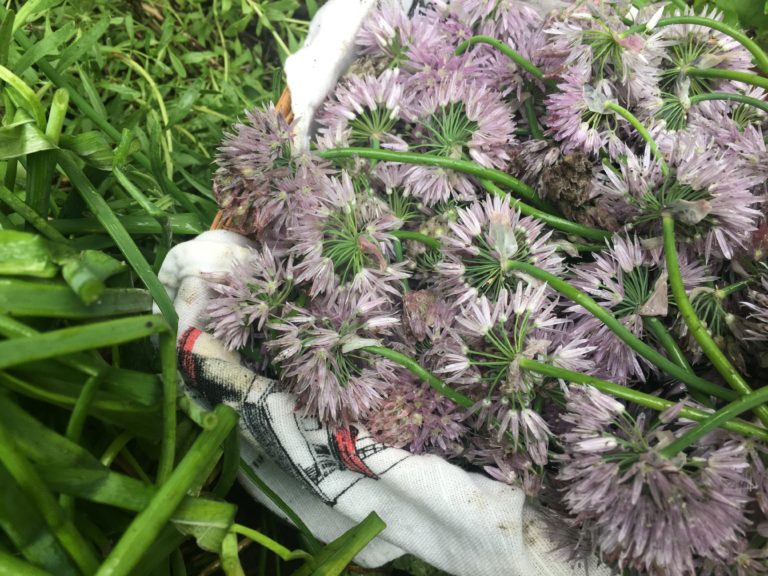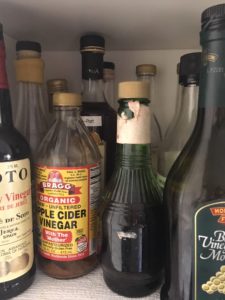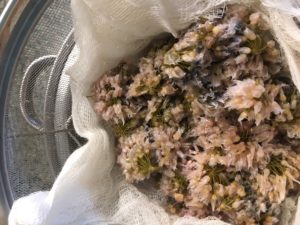
I have become a vinegar addict.
For most of my cooking life, I knew that a squeeze of lemon would perk up a dish and help bring other flavors and seasoning into sharper focus without really knowing why. When a recipe called for lemon juice or vinegar, I always reached for the lemon. I can’t remember what I was cooking when, either daringly or out of necessity because I didn’t have lemon on hand, I used some red wine vinegar and whoa! It complemented the dish in a very different way and I was hooked. That additional acidity works magic and varying the means of delivery can really change the way the final dish comes out.
I have a variety of store-bought vinegars on my shelf: red and white wine, champagne, sherry, balsamic, white balsamic, chardonnay, rice, tarragon, and the workhorses apple cider and white. I use them for both cooking and salad dressings (and many uses in the kitchen and around the house for the white distilled vinegar).

I found myself using more vinegar than called for, trying to get a particular balance but ending up with too much vinegar-iness. It came to me that what I wanted was more flavor and body in the vinegar rather than more vinegar itself, and that making my own might get what I was looking for.
Consequently, I’ve begun dabbling in making a variety of different flavors, none of which is difficult to make. It does take some time but most of that is sitting quietly on a shelf doing its thing, while you get on with your thing. Currently in production are red and white wine, pineapple, maple-port, and, just finished, chive-blossom vinegars.
The chive blossom is the easiest one of all and it’s near the end of the flowers here in the northeast US so it seemed a good time to talk about it.
Chives are one of the first things up in my garden in the spring, and a welcome sight they are. Mine were up at the end of April, and then spent the month of March under a blanket of snow from our record-breaking snowy month. They were in bloom at the end of May, and I usually drop a handful into salads, both for the chive flavor but also because they look so pretty. As they pass their prime, I harvest them and make the vinegar.

For this concoction, I use about 2 cups of chive blossoms per 1 ½ cups of white wine vinegar. This is not a hard-and-fast rule for measurement; no need to be precise and you can tinker with the ratios if you want more or less chive flavor.

Heat up the vinegar in a saucepan. You’re just looking to warm it up, not bring it to a boil.
Pour the vinegar over the chive blossoms in a clean glass container. I use the half-gallon canning jars for a lot in my kitchen, and that worked like a charm. Swirl the containers around as the vinegar cools to submerge the blossoms or poke them down with utensil.
After snipping the flowers off their stems, wash them thoroughly in several changes of water. A lot of grit can get trapped in them and you want to make sure to get as much out as you can. This year took me a dozen water changes before they were dirt-free. Drain the flowers well or spin them out in a salad spinner.


After it’s cooled down, cover and let steep for a week or two or until the desired level of chive flavor has developed, preferably in a cool, dark place. Strain out the blossoms; I use a layer or two of cheesecloth in a fine-mesh strainer just to be sure I get out any small bits.
Pour into bottles or into canning jars to store and voila! In addition to the flavor, it’s a really beautiful color.

